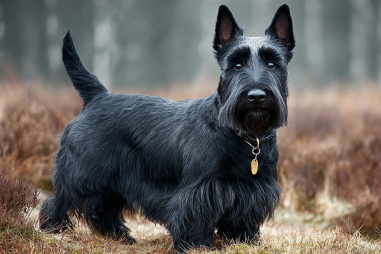Choosing the right dog breed as a family pet is an important decision that can affect household harmony and happiness for years to come. Each breed has its own unique personality, exercise needs, and compatibility with children and other pets. Among the many options, the Scottish Terrier is a distinctive and charming breed that has gained popularity. But are Scottish Terriers the perfect match for your family environment? Let’s explore their temperament, behavior with kids and other pets, activity requirements, training considerations, as well as health and safety factors to help you make an informed choice.
Scottish Terrier Temperament with Kids
Scottish Terriers, often affectionately called “Scotties,” are known for their bold, confident, and independent personalities. Despite their small size, they carry themselves with a dignified and sometimes quite serious demeanor. When it comes to children, Scottish Terriers can form strong bonds and be affectionate companions, but their interaction style requires consideration.
Scotties tend to be loyal and protective of their family members, which can create a wonderful connection with older children who understand how to respectfully engage with a dog. They enjoy attention but may not tolerate overly rough or boisterous play. It’s important to teach kids gentle handling and respect for the dog’s boundaries to foster positive interactions.
Because Scottish Terriers can be somewhat reserved, shy, or wary of strangers, very young children who are unpredictable in their movements may unintentionally trigger stress in the dog. Therefore, Scottish Terriers tend to thrive in families with children who have a calmer, more consistent approach to playing and interaction. These dogs often enjoy participating in daily family activities, offering companionship without demanding constant attention.
Interaction with Other Household Pets
Scottish Terriers have a strong prey drive as a terrier breed, meaning they were originally bred to hunt and chase small animals. This instinct can influence how they interact with other pets in the home. For families with cats or smaller pets such as rabbits or rodents, careful introduction and supervision is crucial.
With proper socialization from a young age, many Scotties can learn to coexist peaceably with other dogs and pets. However, their assertive and independent nature means they often prefer to be the dominant dog, especially in multi-dog households. Some Scottish Terriers may be territorial, so introducing them gradually and monitoring behavior closely helps reduce conflicts.
For families without other pets, Scotties can still be content, especially if given enough mental and physical stimulation. Their alertness and protective nature also make them good watchdogs, alerting the family to any unusual activity around the home.
Space and Activity Requirements
One appealing factor of Scottish Terriers is their adaptability to various living environments. They are relatively small dogs, typically weighing between 18 to 22 pounds, making them suitable for apartment or house living. That said, they do have moderate activity needs.
Scotties benefit from daily walks and time spent outdoors exploring. They love to engage their keen noses with tracking or scent games and often enjoy digging, which can be channeled into appropriate activities like digging pits in the yard. Because of their hunting background, they relish tasks that challenge their intelligence and senses.
While not as high-energy as some working or sporting breeds, Scottish Terriers still need regular exercise to prevent boredom and potential destructive behaviors. Families who enjoy outdoor activities or can provide stimulating play sessions will find a happy and balanced companion in a Scottie.
Training Implications for Families
Training a Scottish Terrier requires patience, consistency, and positive reinforcement techniques. Their independent streak may lead them to be somewhat stubborn, so families should be prepared for some persistence when teaching commands and house rules.
- Early socialization: Introducing your Scottie puppy to a variety of people, pets, and environments helps create a well-rounded adult dog.
- Firm but gentle guidance: Harsh corrections can backfire with a Scottie’s sensitive nature, so rewards, praise, and treats work best.
- Consistency: Scottish Terriers respond well to routines and clear boundaries, which benefit busy family schedules.
Because they can be territorial, leash training and reliable recall are important to manage their sometimes independent behavior. Additionally, teaching children how to properly interact and give commands can foster a harmonious relationship between kids and the household dog.
Health and Safety Considerations
Scottish Terriers are generally a healthy breed but do have some breed-specific health risks. Understanding these can help families prepare for lifelong care responsibilities.
- Scottie Cramp: A genetic condition causing muscle spasms and difficulty walking during stressful moments, usually manageable with veterinary care.
- Von Willebrand’s Disease: A bleeding disorder that requires awareness during surgeries or injuries.
- Skin Issues: They can be prone to allergies or dermatitis, which might require dietary management or treatments.
- Respiratory Conditions: Due to their short muzzles, monitoring for breathing difficulties is helpful.
Regular veterinary check-ups, a balanced diet, and moderate exercise contribute to their overall well-being. From a safety perspective, Scottish Terriers should not be left unsupervised with very young children, especially if either the dog or child doesn’t understand respectful boundaries.
Pros and Potential Challenges
Like all breeds, Scottish Terriers come with advantages and some challenges that families should weigh.
Pros
- Loyal and devoted companions with a strong bond to their family.
- Relatively small size suitable for a variety of living situations.
- Alert watchdogs, providing security at home.
- Moderate exercise needs manageable with daily walks and play.
- Unique, charming appearance and dignified personality.
Potential Challenges
- Independent and stubborn streak can make training challenging.
- May be reserved or aloof with strangers and young children.
- Strong prey drive can complicate introductions to smaller pets.
- Tendency towards certain genetic health issues requiring active care.
- Not always tolerant of rough play; needs respectful children or adult supervision.
Finding the Right Fit for Your Family
When considering a Scottish Terrier as a family pet, the most important factor is matching the breed’s temperament and needs to your household’s lifestyle and dynamics. Scottish Terriers thrive in homes where members are willing to invest time in training, socialization, and healthy exercise routines.
Families with older or more gentle children, or those without very small pets, will likely find a Scottie to be a delightful, loyal friend. For households seeking a dog with a bold yet dignified personality who can serve as a watchdog and affectionate family member, the Scottish Terrier offers unique qualities that are both satisfying and rewarding.
Ultimately, bringing a Scottish Terrier into your home means committing to understanding their nature and ensuring a nurturing environment where both dog and family can grow happily together.







